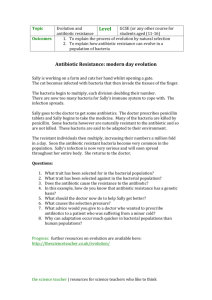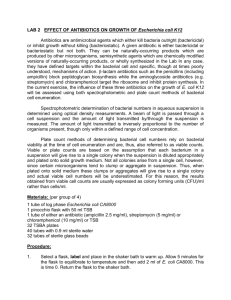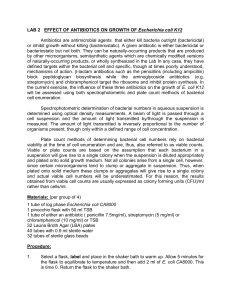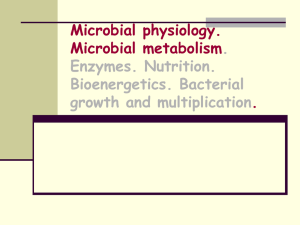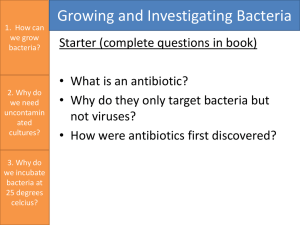BIO 208 Microbiology Unit 2 Test Practice
advertisement
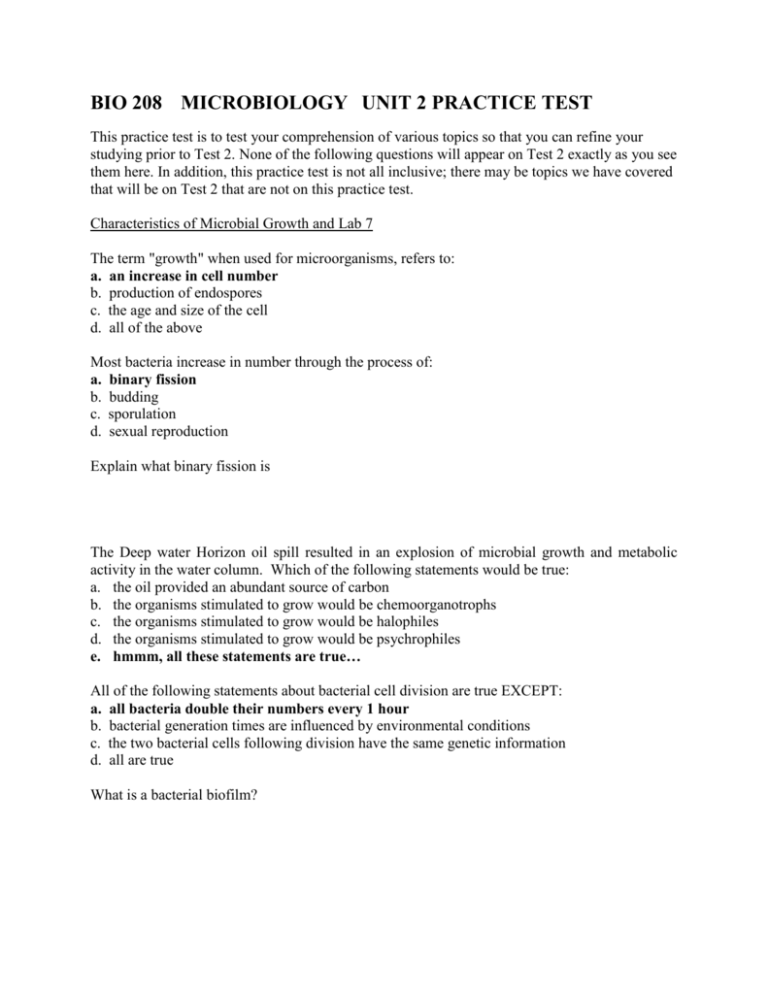
BIO 208 MICROBIOLOGY UNIT 2 PRACTICE TEST This practice test is to test your comprehension of various topics so that you can refine your studying prior to Test 2. None of the following questions will appear on Test 2 exactly as you see them here. In addition, this practice test is not all inclusive; there may be topics we have covered that will be on Test 2 that are not on this practice test. Characteristics of Microbial Growth and Lab 7 The term "growth" when used for microorganisms, refers to: a. an increase in cell number b. production of endospores c. the age and size of the cell d. all of the above Most bacteria increase in number through the process of: a. binary fission b. budding c. sporulation d. sexual reproduction Explain what binary fission is The Deep water Horizon oil spill resulted in an explosion of microbial growth and metabolic activity in the water column. Which of the following statements would be true: a. the oil provided an abundant source of carbon b. the organisms stimulated to grow would be chemoorganotrophs c. the organisms stimulated to grow would be halophiles d. the organisms stimulated to grow would be psychrophiles e. hmmm, all these statements are true… All of the following statements about bacterial cell division are true EXCEPT: a. all bacteria double their numbers every 1 hour b. bacterial generation times are influenced by environmental conditions c. the two bacterial cells following division have the same genetic information d. all are true What is a bacterial biofilm? 2 Use this typical growth curve to answer questions c b d a Which section shows a phase where the number of cells that are dying equals the number of cells that are dividing? a. A b. B c. C d. D Where would an antibiotic that inhibits bacterial peptidoglycan synthesis be most effective? a. A b. B c. C d. D Antibiotics are produced by bacteria when optimal growth conditions begin to deteriorate. During which part of the growth curve would bacteria be secreting antibiotics? a. A b. B c. C d. D What is the best definition of a “pure culture”? a. a culture that contains only one type of microorganism b. a culture that contains only one cellular morphology of bacterium (e.g., rods) c. an agar plate of bacteria that has not been contaminated with mold d. bacterial colonies that are uniform in color What is the desired result of the quadrant streak plate technique? a. cover the entire surface of the agar with a maximum amount of bacterial growth b. determine the quantity of bacteria in the original culture c. obtain growth of only Gram positive cocci d. obtain well isolated bacterial colonies 2 3 You are attempting to prepare pour plates but your agar deep hardens before you can pour the plate. You can re-melt your agar by putting the agar back into the 50°C waterbath: a. true b. false All of the following are true about the enzymes of alkaliphiles EXCEPT that they: a. have an activity optimum at pH above neutral b. will be denatured at lower pH c. are added to laundry detergent d. are found in stomach acid Most bacteria that cause diseases in humans have a temperature optimum of approximately: a. 4C b. 22C c. 37C d. 80C Which organism could be found living in a Yellowstone hotspring? a. thermophile b. mesophile c. metaphile d. psychrophile Which of the following microorganisms is an example of a hyperthermophile? a. Chlamydomonas nivalis b. Escherichia coli c. Pyrolobus fumarii d. Staphylococcus aureus Why is molecular oxygen (O2) a toxic molecule for cells? a. it inhibits cellular respiration b. it generates an osmotic potential and causes water to flow into the cell c. free radicals produced during O2 reduction pull electrons off of DNA d. both b and c Which of the following types of organisms possess the enzyme catalase? a. obligate aerobe b. obligate anaerobe c. facultative anaerobe d. both a and c 3 4 Control of Microbial Growth, Antibiotics, Antibiotic Resistance and Lab 8 Why do temperatures above a microorganism's maximum cause cell death? a. plasma membranes collapse b. nucleic acids denature c. proteins denature d. all of the above How are the actions of phenols and alcohols similar as agents that kill microbes? a. both denature proteins b. both oxidize DNA c. both inhibit nucleic acid synthesis d. all of the above Who discovered penicillin? a. Fleming b. Koch c. Lister d. Pasteur What is the best definition of an antibiotic? a. chemotherapeutic agent that is affective against bacteria, viruses, and fungi b. man-made chemical used to treat infectious diseases c. natural substance produced by one microorganism that inhibits the growth of another microorganism Match each antibiotic to its site of action b penicillin a. nucleic acid synthesis c nystatin b. peptidoglycan synthesis a rifampin c. plasma membrane integrity and function d tetracycline d. protein synthesis Which antibiotic above would be least toxic to your cells? Penicillin You visit your doctor because of a cough and slight fever of 99F. The doctor prescribes an antibiotic that you are to take 2 times a day for 5 days. You take the first dose and a second dose 12 hours later. 2 hours after taking the second dose of antibiotic your fever goes up to 102F. Based on this scenario, which of the following statements are possible? a. your illness is caused by a virus b. the antibiotic prescribed does not target the bacteria that are causing your illness c. both are possible 4 5 All of the following statements are true about antibiotic resistance EXCEPT: a. it can develop during a course of antibiotic treatment b. it has become a serious problem in the United States c. it can be reversed by discontinuing the use of certain antibiotics for a few years d. it is a result of misuse and overuse of antibiotics Which equation is catalyzed by the enzyme catalase? a. C6H12O6 + 6O2 6CO2 + 6H2O b. 2H2O2 2H2O + O2 c. 2O2 + 2H+ O2 + H2O2 d. NO3- + 2H+ + 2e- NO2- You have spread a bacteria suspension out over the surface of an agar plate and added disks impregnated with chemical agents X, Y, and Z. Following overnight incubation you make the following observations. A large clear zone surrounds agents X and Y, the bacteria grow right up to the edge of agent Z. Which statement is true: a. the bacteria are most susceptible to agent Z b. the bacteria are resistant to agent Z c. the clear zones around agents X and Y are called “zones of inhibition” d. b and c are both true. Basic Metabolism – from BIO 110 or read on your own and Labs 9, 10, 11 All of the following organisms are correctly matched with their source of energy EXCEPT: a. phototroph – light b. autotroph – CO2 c. lithotroph – FeS d. organotroph – glucose How many net ATP are produced from oxidation of glucose to pyruvate by glycolysis? a. 2 b. 4 c. 6 d. 38 Why can't oxidation of glucose to pyruvate be the final stage in glucose catabolism? a. it does not produce enough energy for bacteria to grow b. it does not allow for re-oxidation of NADH to NAD+ c. because pyruvate is toxic d. all of the above 5 6 In an organism that undergoes fermentation, pyruvate may be: a. oxidized in the TCA cycle b. oxidized in the electron transport chain c. oxidized by glycolysis d. reduced to lactic acid In addition to the 2ATP formed through glycolysis, how many additional ATP are formed during fermentation? a. 0 b. 2 c. 4 d. 26 All of the following are necessary for respiration EXCEPT: a. a source of electrons b. electron carriers c. electron transport chain d. oxygen Nitrobacter use carbon dioxide as their carbon source and nitrite as their energy source. These bacteria are: a. phototrophic autotrophs b. phototrophic heterotrophs c. chemoorganotrophic autotrophs d. chemolithotrophic autotrophs What is an exoenzyme? a. amylase b. an enzyme secreted by bacteria that breaks large substrates into smaller components c. a hydrolytic enzyme d. all of the above In order for a bacterium to utilize starch it must: a. break the polysaccharide starch into glucose units b. hydrolyze starch outside the bacterial cell c. secrete ammonia d. both a and b The Indole test checks for the formation of the product______________ from the amino acid tryptophan while the Voges-Proskauer tests for the production of ____________ from glucose. a. mixed acids; acetoin b. indole; mixed acids c. tryptophanase; mixed acids d. indole; acetoin 6 7 In the Citrate test, citrate is the: a. carbon source b. electron acceptor c. enzyme d. pH indicator Match the following terms with appropriate examples (examples may be used as often as needed) a,b,c,d,f,g,h,i e a,b,d,f,g,h,i c a d,i b d a,b,c,d,g,i i a,c,d d b,d,f,g,h d Chemoorganotroph Chemolithotroph Heterotroph Autotroph Obligate aerobe Facultative anaerobe Obligate anaerobe Coliform Mesophile Halophile Aerobic respiration Anaerobic respiration Fermentation Fecal-oral route of transmission Examples a. Bacillus b. Bacteroides c. cyanobacteria d. E. coli e. FeS2 f. Glucose g. Lactic acid bacteria h. Lactose i. Staphylococcus aureus 7


